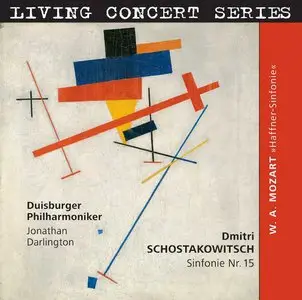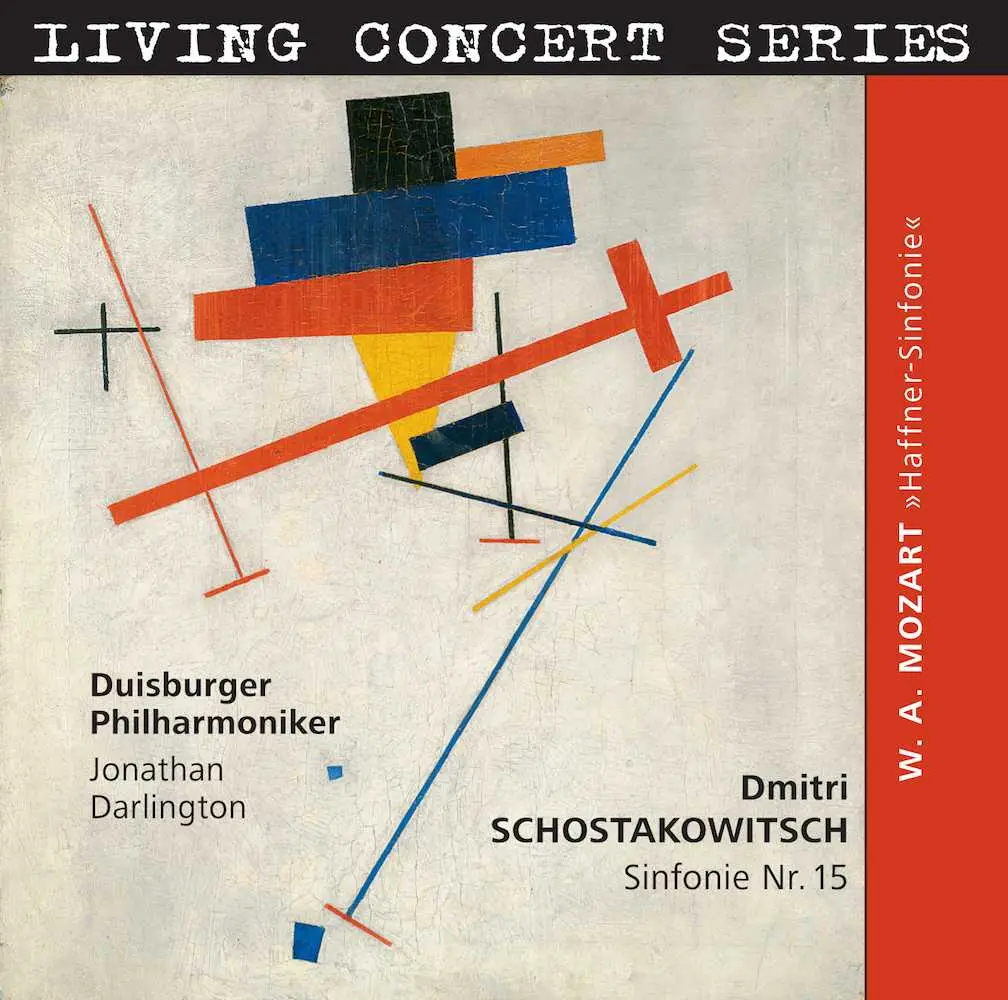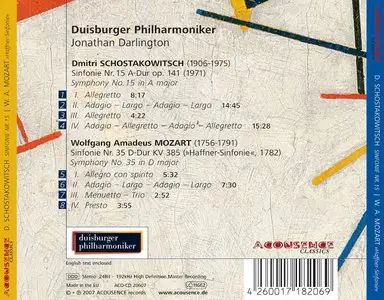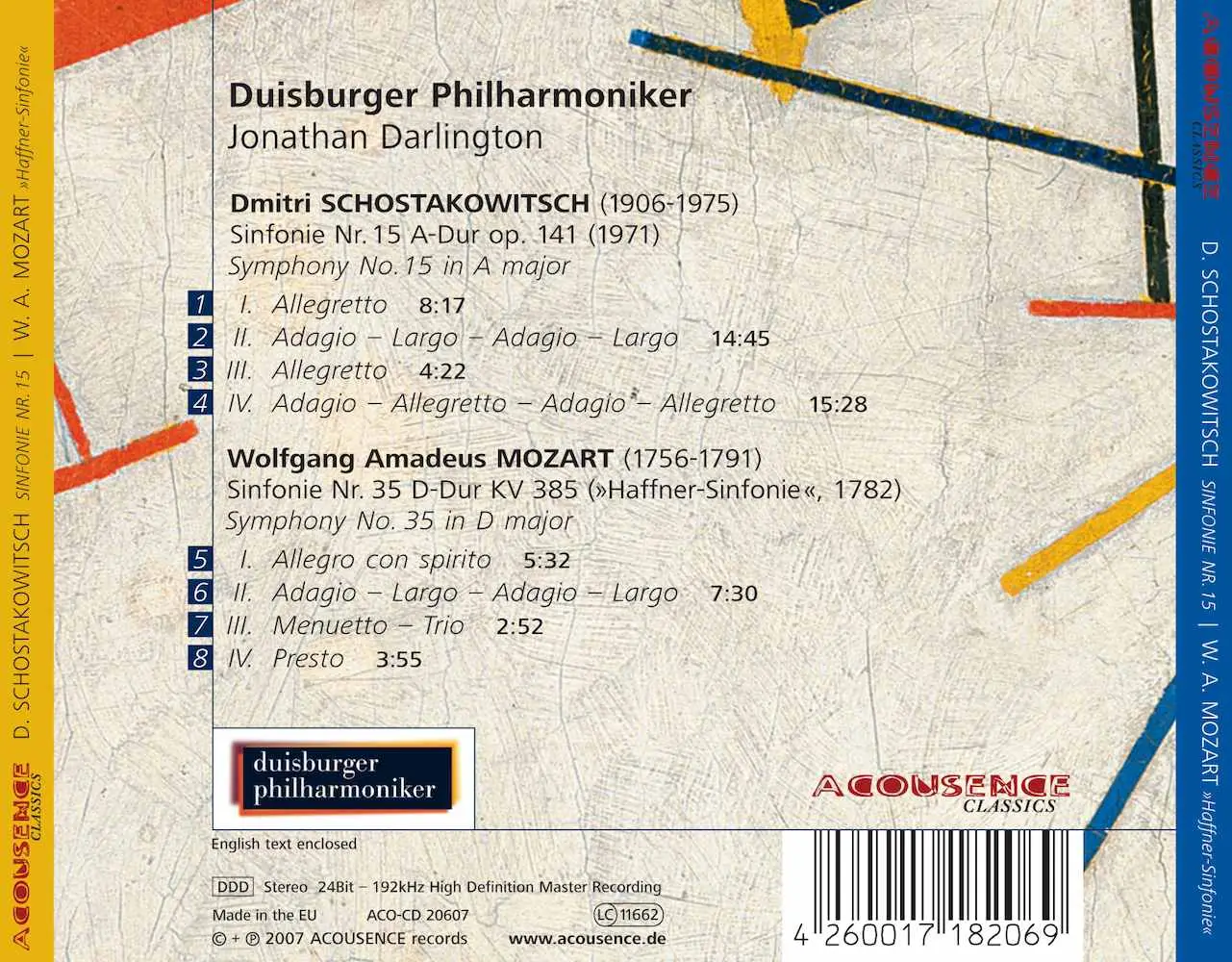Duisburg Philharmonic Orchestra dir. Jonathan Darlington - Shostakovich Symphony No. 15 and Mozart Haffner-Sinfonie
FLAC 192KHz / 24Bit | Full Artwork | Stereo | 2.30GB | 2009
These are Studio Master files from Linn Records, so NO LOG and NO CUE. See www.linnrecords.com for more details.
The Living Concert Series embodies, in a very special way, the basic concept behind Acousence's Philosophy label. The Symphony No. 15 in A major op. 141 is Dimitri Shostakovich's last orchestral work. It was written in 1971, four years before the composer's death, and although the symphony bears the distinct traces of a late work and Shostakovich had been struck by a serious illness, this is by no means his last musical creation. The "Haffner-Symphony" was written in a turbulent time: Only one year before, in March 1781, Mozart had given up his secure post at the court of the archiepiscopal court in Salzburg and he was now trying to build up a position as a self-employed musician. On July 16th the "Entführung aus dem Serail" had been premiered at the Viennese Burgtheater. It was the time when Mozart married Constanze Weber against the will of his father.The Studio Master files are 192kHz / 24 bit.
Recording & mixing engineer, editor: Ralf Koschnicke
Recording facilities: ACOUSENCE recording mobile / ACOUSENCE recordings
Recording location: Theater am Marientor, Duisburg, 30./31.08.2006
Publisher: © by MUSIKVERLAG HANS SIKORSKI GMBH & CO. KG
c & p 2007 ACOUSENCE records
This album is licensed for download from Acousence Records.
Dimitri Shostakovich's Fifteenth Symphony
The Symphony No. 15 in A major op. 141 is Dimitri Shostakovich's last orchestral work. It was written in 1971, four years before the composer's death, and although the symphony bears the distinct traces of a late work and Shostakovich had been struck by a serious illness, this is by no means his last musical creation.
"I want to write a happy symphony" Dimitri Shostakovich said to his younger colleague Boris Tischtschenko at the beginning of the year 1971. He had already been working on the new work for some time, but the first sketches were only completed in April. While returning from taking a cure on 27th June, he said to Alexander Cholodilin who was waiting for him at the railway station, that the work on the new symphony was finished, and a few days later the instrumentation was also completed. Retrospectively the composer remembered:
"I have done a lot of work on it. I wrote it in hospital, and later also, at the datcha, it gave me no peace. This is a work which simply swept me along with it, one of the few works which was completely clear to me from the beginning - from the first to the last note. It only had to be written down."
Although this symphony, with which Shostakovich returned to the classical four-movement structure after nearly two decades, contains humorous elements, it is in reality a humour not to be trusted, and in many places the composition takes on an almost suffocating density of expression. The instrumentation is economical, and quotation plays an important role.
The first movement carries reminders of his early work, with pronounced sarcastic features. The five repetitions of the gallop from Gioacchino Rossini's 'William Tell' overture may at first amuse, but the isolation and foreignness of these unexpected inserts appear ultimately particulary threatening. The short first movement is economically orchestrated and includes numerous solos. The exposition allows the woodwind to dominate, in the development the percussion instruments make themselves heard and finally involve the brass group. The reprise substantially changes the opening material, and ends with an abrupt tutti blow. In this way Shostakovich reminds us of a world which in this form no longer exists. The composer himself called this movement a "toy shop" but the conductor Kurt Sanderling qualifies this by arguing that in this "toy shop" there are only soulless, dead toys which only come to life when they are operated like puppets.
The gloomy Adagio has the character of a funeral march. Here a twelve-tone-theme of the solo cello weaves through the brass chorale. Later a solo violin also joins in and the first trombone takes on a solo function, too. There are particular associations with the first movement of the sixth symphony, and after a climax, the tension is taken away gradually, until the Adagio leads directly into the third movement.
This third movement is one of the shortest Shostakovich-scherzos. Sparingly instrumented the music seems almost skeletonized. The main theme is again twelve-tone structured, which is contrasted by the commitment to weighty bassoon fifths. The last Shostakovich symphony reaches its climax in its finale. The movement is opened by three significant Wagner-quotes. The brass plays the Destiny-motive from "Walküre" first, the timpani rhythm of the funeral music from "Götterdämmerung" follows. In contrast to these, the opening motive from "Tristan und Isolde" is taken up, which then directly flows into the calm main theme of the movement. The character of the second subject can hardly be called dramatic either, which is the reason why this disposition knows no parallels in the final movements of the Shostakovich's symphonies. The dramatic development only begins in the middle part, a monumental Passacaglia, which corresponds to the "Invasion Eposode" in the "Leningrad" Symphony. After the break-down, when the work with twelve-tone themes and the reprise of motives from the first movements have become superfluous, the percussion instruments have the last word. In this ghostly section the conductor Kurt Sanderling was reminded of the intensive care unit of a hospital, where in this case the vanishing of all life functions is displayed.
Under the direction of Maxim Schostakovich, the composer's son, the fifteenth symphony was premiered on January 8, 1972 in Moscow. What subsequently happened? Shostakovich took the longest break from working in his lifetime and did not compose a single note for one and a half years. Instead, he went on several journeys, received official honours and gained increasing international recognition. After the fifteenth symphony he wrote two string quartets, the Michelangelo songs for bass and piano, and a moving sonata for viola and piano. After several heart-attacks Dmitri Schostakovich died from cancer on August 9, 1975.
Wolfgang Amadeus Mozart's "Haffner-Symphony"
In the year 2006 the 100th birthday of Dmitri Schostakovich was remembered, but the 250th birthday of Wolfgang Amadeus Mozart outshone all other jubilees. Mozart's "Haffner-Symphony", the symphony No. 35, is the first of altogether six exceedingly significant Viennese symphonies.
The "Haffner-Symphony" was written in a turbulent time: Only one year before, in March 1781, Mozart had given up his secure post at the court of the archiepiscopal court in Salzburg and he was now trying to build up a position as a self-employed musician. On July 16th the "Entführung aus dem Serail" had been premiered at the Viennese Burgtheater. It was the time when Mozart married Constanze Weber against the will of his father.
Mozart received at this time a commission for a composition from Salzburg. Sigmund Haffner (1756-1787), the son of the Salzburg mayor, for whom he had already written the "Haffner Serenade" KV 250 six years before on the occasion of the marriage of his sister Elisabeth, was knighted on 29th July, 1782. For the festivities on the occasion of this event, a composition was needed. If you consider Mozart's version of the 27th of July, one detects that the "Haffner-Symphony" was originally to receive a serenade form, but the composer later relinquished the introductory march and a second minuet.
The "Haffner-Symphony" was first heard in the form as it is known today on 23rd March 1783, at an academy concert in the Viennese Burgtheater. In order to heighten the effect of this composition, Mozart made further changes in the music for this event.
"This will surely make a good impression", Mozart was already sure, and indeed the success of the "Haffner-Symphony" is not astonishing: The character of the movements contrast effectively with each other, and the themes have been invented in an exceedingly original manner. The fiery character of the first movement results not least out of the poignant introductory motive, which only consists of a few tonal steps, which seem repeatedly torn two octaves apart. The beginning is spectacular, the treatment of it is decidedly artistic, so that this main theme is nearly omnipresent.
In contrast to this the Andante underlines the graceful serenade character. One could speak of a proper little night music, for the high strings unfold an unprecedented melodic bliss, and due to the interjections of the oboes and bassoons the movement obtains a colouring which rather enchants than distracts.
At the third position one finds a minuet which could be called classical in its disposition: Well balanced in both their proportions the composer puts the vigorous first section, with its triad progressions over two octaves, side by side with a calming, swinging second section, and in opposition to these great swellings, there are narrow sequences with low sound volume in the Trio. As in the first movement, the finale also begins with an insignificant unison phrase, but this time in piano. An abundance of ideas, which keep the movement in constant motion, follows.
Michael Tegethoff (Translation: Michael Millard)
The Symphony No. 15 in A major op. 141 is Dimitri Shostakovich's last orchestral work. It was written in 1971, four years before the composer's death, and although the symphony bears the distinct traces of a late work and Shostakovich had been struck by a serious illness, this is by no means his last musical creation.
"I want to write a happy symphony" Dimitri Shostakovich said to his younger colleague Boris Tischtschenko at the beginning of the year 1971. He had already been working on the new work for some time, but the first sketches were only completed in April. While returning from taking a cure on 27th June, he said to Alexander Cholodilin who was waiting for him at the railway station, that the work on the new symphony was finished, and a few days later the instrumentation was also completed. Retrospectively the composer remembered:
"I have done a lot of work on it. I wrote it in hospital, and later also, at the datcha, it gave me no peace. This is a work which simply swept me along with it, one of the few works which was completely clear to me from the beginning - from the first to the last note. It only had to be written down."
Although this symphony, with which Shostakovich returned to the classical four-movement structure after nearly two decades, contains humorous elements, it is in reality a humour not to be trusted, and in many places the composition takes on an almost suffocating density of expression. The instrumentation is economical, and quotation plays an important role.
The first movement carries reminders of his early work, with pronounced sarcastic features. The five repetitions of the gallop from Gioacchino Rossini's 'William Tell' overture may at first amuse, but the isolation and foreignness of these unexpected inserts appear ultimately particulary threatening. The short first movement is economically orchestrated and includes numerous solos. The exposition allows the woodwind to dominate, in the development the percussion instruments make themselves heard and finally involve the brass group. The reprise substantially changes the opening material, and ends with an abrupt tutti blow. In this way Shostakovich reminds us of a world which in this form no longer exists. The composer himself called this movement a "toy shop" but the conductor Kurt Sanderling qualifies this by arguing that in this "toy shop" there are only soulless, dead toys which only come to life when they are operated like puppets.
The gloomy Adagio has the character of a funeral march. Here a twelve-tone-theme of the solo cello weaves through the brass chorale. Later a solo violin also joins in and the first trombone takes on a solo function, too. There are particular associations with the first movement of the sixth symphony, and after a climax, the tension is taken away gradually, until the Adagio leads directly into the third movement.
This third movement is one of the shortest Shostakovich-scherzos. Sparingly instrumented the music seems almost skeletonized. The main theme is again twelve-tone structured, which is contrasted by the commitment to weighty bassoon fifths. The last Shostakovich symphony reaches its climax in its finale. The movement is opened by three significant Wagner-quotes. The brass plays the Destiny-motive from "Walküre" first, the timpani rhythm of the funeral music from "Götterdämmerung" follows. In contrast to these, the opening motive from "Tristan und Isolde" is taken up, which then directly flows into the calm main theme of the movement. The character of the second subject can hardly be called dramatic either, which is the reason why this disposition knows no parallels in the final movements of the Shostakovich's symphonies. The dramatic development only begins in the middle part, a monumental Passacaglia, which corresponds to the "Invasion Eposode" in the "Leningrad" Symphony. After the break-down, when the work with twelve-tone themes and the reprise of motives from the first movements have become superfluous, the percussion instruments have the last word. In this ghostly section the conductor Kurt Sanderling was reminded of the intensive care unit of a hospital, where in this case the vanishing of all life functions is displayed.
Under the direction of Maxim Schostakovich, the composer's son, the fifteenth symphony was premiered on January 8, 1972 in Moscow. What subsequently happened? Shostakovich took the longest break from working in his lifetime and did not compose a single note for one and a half years. Instead, he went on several journeys, received official honours and gained increasing international recognition. After the fifteenth symphony he wrote two string quartets, the Michelangelo songs for bass and piano, and a moving sonata for viola and piano. After several heart-attacks Dmitri Schostakovich died from cancer on August 9, 1975.
Wolfgang Amadeus Mozart's "Haffner-Symphony"
In the year 2006 the 100th birthday of Dmitri Schostakovich was remembered, but the 250th birthday of Wolfgang Amadeus Mozart outshone all other jubilees. Mozart's "Haffner-Symphony", the symphony No. 35, is the first of altogether six exceedingly significant Viennese symphonies.
The "Haffner-Symphony" was written in a turbulent time: Only one year before, in March 1781, Mozart had given up his secure post at the court of the archiepiscopal court in Salzburg and he was now trying to build up a position as a self-employed musician. On July 16th the "Entführung aus dem Serail" had been premiered at the Viennese Burgtheater. It was the time when Mozart married Constanze Weber against the will of his father.
Mozart received at this time a commission for a composition from Salzburg. Sigmund Haffner (1756-1787), the son of the Salzburg mayor, for whom he had already written the "Haffner Serenade" KV 250 six years before on the occasion of the marriage of his sister Elisabeth, was knighted on 29th July, 1782. For the festivities on the occasion of this event, a composition was needed. If you consider Mozart's version of the 27th of July, one detects that the "Haffner-Symphony" was originally to receive a serenade form, but the composer later relinquished the introductory march and a second minuet.
The "Haffner-Symphony" was first heard in the form as it is known today on 23rd March 1783, at an academy concert in the Viennese Burgtheater. In order to heighten the effect of this composition, Mozart made further changes in the music for this event.
"This will surely make a good impression", Mozart was already sure, and indeed the success of the "Haffner-Symphony" is not astonishing: The character of the movements contrast effectively with each other, and the themes have been invented in an exceedingly original manner. The fiery character of the first movement results not least out of the poignant introductory motive, which only consists of a few tonal steps, which seem repeatedly torn two octaves apart. The beginning is spectacular, the treatment of it is decidedly artistic, so that this main theme is nearly omnipresent.
In contrast to this the Andante underlines the graceful serenade character. One could speak of a proper little night music, for the high strings unfold an unprecedented melodic bliss, and due to the interjections of the oboes and bassoons the movement obtains a colouring which rather enchants than distracts.
At the third position one finds a minuet which could be called classical in its disposition: Well balanced in both their proportions the composer puts the vigorous first section, with its triad progressions over two octaves, side by side with a calming, swinging second section, and in opposition to these great swellings, there are narrow sequences with low sound volume in the Trio. As in the first movement, the finale also begins with an insignificant unison phrase, but this time in piano. An abundance of ideas, which keep the movement in constant motion, follows.
Michael Tegethoff (Translation: Michael Millard)
01 July 2009
klassik-heute.de
Benjamin G. Cohrs
4½ Stars
An atmospherically concise piece, a respiring string sound, various colour effects and a powerful internal force characterise this live recording - an extremely intensive, impressive performance, more than worth being captured on CD. A definite 9.
klassik-heute.de
Benjamin G. Cohrs
4½ Stars
An atmospherically concise piece, a respiring string sound, various colour effects and a powerful internal force characterise this live recording - an extremely intensive, impressive performance, more than worth being captured on CD. A definite 9.
01 - Symphony No 15 in A major op 141 I Allegretto.flac
02 - Symphony No 15 in A major op 141 II Adagio Largo Adagio Largo.flac
03 - Symphony No 15 in A major op 141 III Allegretto.flac
04 - Symphony No 15 in A major op 141 IV Adagio Allegretto Adagio Allegretto.flac
05 - Symphony No 35 in D major Haffner KV 385 I Allegro con spirito.flac
06 - Symphony No 35 in D major Haffner KV 385 II Andante.flac
07 - Symphony No 35 in D major Haffner KV 385 III Menuetto Trio.flac
08 - Symphony No 35 in D major Haffner KV 385 IV Presto.flac
02 - Symphony No 15 in A major op 141 II Adagio Largo Adagio Largo.flac
03 - Symphony No 15 in A major op 141 III Allegretto.flac
04 - Symphony No 15 in A major op 141 IV Adagio Allegretto Adagio Allegretto.flac
05 - Symphony No 35 in D major Haffner KV 385 I Allegro con spirito.flac
06 - Symphony No 35 in D major Haffner KV 385 II Andante.flac
07 - Symphony No 35 in D major Haffner KV 385 III Menuetto Trio.flac
08 - Symphony No 35 in D major Haffner KV 385 IV Presto.flac
Part of Linn Products Ltd, world leaders in sound reproduction equipment, Linn Records was formed in 1983.
While Linn engineers were testing their flagship product, the Sondek LP12 turntable, they became frustrated with the poor quality of some of the specialist test LPs they were using. The measurements were swamped by record imperfections. Better test discs were needed so work began on an LP cutting lathe as a research product to improve testing for the LP12.
The first albums to be cut and subsequently released were Carol Kidd's debut album and A Walk Across the Rooftops by the Blue Nile. Thus Linn Records was born…
Today the label is one of the world's leading audiophile labels specialising in classical, jazz and Celtic music. We reproduce our music on CD (or SACD), Vinyl and now as high quality Downloads.
We exist to introduce the broadest range of involving musical experiences to a worldwide audience of discriminating individuals who are on a personal quest of musical ecstasy and enlightenment. The beautiful compositions and artistic performances are perfectly captured by our expert engineers on recordings of unprecedented truth.
There is a whole world of Linn music to explore. The high quality sound reproduction that results from our investment of time and effort means that as a listener you can simply hear more, and hear it more clearly. It can sound uncannily like the musicians are in the room with you. As the true qualities of the music are more audible, music that you never thought would move you starts to make sense, and its seductive power can be tremendous. Please have a listen to our music and judge for yourselves. Sound clips are available on all the album pages.
We believe music is essential for human well-being and the better it is reproduced the more benefit it delivers. Because of this we record our music to the highest specification. This means that great care is taken in recording sessions and in the manufacturing process to ensure that the atmosphere and integrity of the musical performance is maintained.
Our people all have a love of music and pay high attention to detail. Find out about the key personnel and read an interview with one of our top sound engineers.
We pride ourselves in looking after you and aim to provide an excellent service. We treat your details with confidentiality, we do not pass on or sell your details to other companies and we have put security certificates in place to protect your payment details.
We are a small team based in the countryside just South of Glasgow in Scotland.
Linn Records is a subsidiary company of Linn Products - an independent company specialising in precision engineered sound and vision. Linn Products was founded in 1972 by Ivor Tiefenbrun to produce the Linn Sondek record player, which is still in production. Today, Linn designs and manufactures an extensive range of original products, renowned for their performance, and sold around the world. Systems range from £1000 to £1m.
Downloads
http://rapidshare.com/files/323067011/duishomoz.part01.rar
http://rapidshare.com/files/323066961/duishomoz.part02.rar
http://rapidshare.com/files/323067674/duishomoz.part03.rar
http://rapidshare.com/files/323067078/duishomoz.part04.rar
http://rapidshare.com/files/323068364/duishomoz.part05.rar
http://rapidshare.com/files/323068536/duishomoz.part06.rar
http://rapidshare.com/files/323068580/duishomoz.part07.rar
http://rapidshare.com/files/323069293/duishomoz.part08.rar
http://rapidshare.com/files/323070388/duishomoz.part09.rar
http://rapidshare.com/files/323070232/duishomoz.part10.rar
http://rapidshare.com/files/323070577/duishomoz.part11.rar
http://rapidshare.com/files/323070829/duishomoz.part12.rar
http://rapidshare.com/files/323070920/duishomoz.part13.rar
johhenrik







